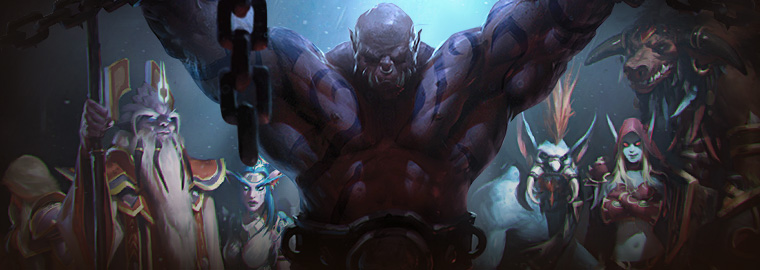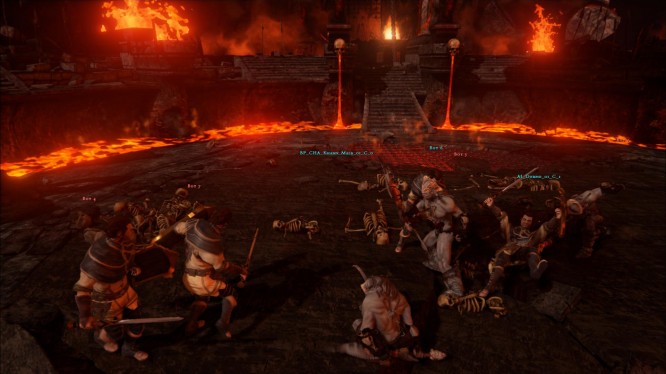

The World of Warcraft has been around for more than a decade, and even now it continues to exert its influence on the MMO industry, not for a single moment being as irrelevant as the last random F2P title you played for five minutes. Whether you like it or not, WoW is still going strong despite its drop in subscriptions since its peak, and with Warlords of Draenor dropping soon, it’ll be even less of an issue. It does make me wonder though; how has WoW lasted this long and still this powerful?
“WoW wasn’t the first MMO” is a very common thing we hear when there are arguments about such, and that is definitely true. There have been an already immense buffet of MMOs available in the market at the time and WoW was only going to add to that. However, no matter how you feel about WoW, it did popularize the genre and its elements have become staples in every game past its initial release. Due to its sheer popularity and Blizzard’s own fanciful flair for marketing, WoW had become the mainstream game, the industry-breaking MMO, and proving it was there to stay. Other games like Everquest, which only ever held acclaim in the western markets, and Ragnarok Online, which had always only had the interest of the Asian markets, were incapable of matching the worldly WoW in terms of accessibility and marketing, as well as content and depth.

…this is an element I wish was worked on better.
Since WoW had clearly defined the formula for a successful MMO, many jumped on the online bandwagon and started developing games that were designed to “kill” WoW, albeit ironically copying many of its popular elements like the combat system. There were many attempts at this, but none are successful up to this date, and that is because WoW itself has always been invoked in some way. Beckoning the masses to try and play a WoW-killer was merely giving the MMO giant more strength, urging comparisons between games that simply could not keep up with WoW’s content with each passing year.
Especially at the present time, where WoW is just so entrenched in the industry, it is hard to ignore it for any reason other than straight-forward snobbery. It’s just there and it is not going anywhere anytime soon, so developers and players alike will either accept it as it already is a norm in today’s industry, or try to deviate from its powerful gravitational force. Many of us get sick of WoW at some point and move onto another game which we mostly decide to be vastly superior, but we keep ending up coming back to WoW or quitting MMOs entirely. This is because we are creatures of habit; we are so used to the concepts introduced and popularized by WoW that we consider it as the mythril-standard of the industry, subconsciously looking for the familiarity it held. MMOs like WAR, SWTOR, and the like have attempted to take down WoW, and despite them being fantastic games all on their own, players really can’t shake the feeling of discomfort when they see how similiar, or dissimilar, as the case may be, it is to WoW. It’s clear that we won’t be shedding off this Warcraft-habit anytime soon, and perhaps only players who have never touched the titan are safe from this.

This is another reason why WoW’s so influential…
Speaking of WoW-killers, as stated earlier, there have been countless other MMOs that took one too many pages from WoW and ended up cloning the entire game up to its actual core. There are some, though, that have attempted to take elements in moderation and introduce their own brand of online magnificence, however, as declared earlier, people are creatures of habit and make other incapable of appreciating how it was crafted and yearned for the MMO titan again or the game simply just lacked direction and content. Take for example the curious case of Warhammer: Age of Reckoning; that was a fantastic game all on its own that took WoW’s combat system as its base and crafted around it a world in which PvP reigns supreme. It took what was a moderate feature of WoW at the time and expanded on it to give such a unique take on the standard and was an absolute blast to play. Many even thought it spelled the end of WoW, but unfortunately, WAR bit off more than it could chew. Content was then the issue as there was only so much one could do in an MMO that depended solely on PvP and player interaction. By the game’s second month, people were flocking back to WoW en masse, giving the WAR world such a dead and dreary disposition of absent defenders in fort battles and extremely long queue times for battlegrounds, and PvE was non-existent. WoW, on the other hand, offered moderation in both PvE and PvP with a lot more things to do past those two spheres of play.

Generic Art or WoW?
WoW clones have nothing to show at all. It just begs the question, “why am I paying for a cheap knockoff when I could just be paying for the original recipe?” The more other developers tried to copy WoW, the less it made sense to play their games against the progenitor. There are some that have achieved moderate success, but perhaps only drawn out by the idea of its IP like Star Wars, but have been going in its own direction despite its base being completely WoW. However, there are those games that took nothing from WoW and took a different direction, especially when Action-MMOs came into existence. Wildstar, The Elder Scrolls Online, and Titanfall are only a few of those games that wanted a different fate from just wallowing in the shadow of WoW, though Wildstar is a curious thing where it openly takes from WoW but innovates on them to create its own style.
If there’s one thing that WoW has it going for it is that it is always polished very well, or extremely well. Sure, there are cases of imbalances between classes and even some all-out uselessness in certain cases, but WoW has always kept their game playable and in pristine condition, not at all ever reaching a point of being unplayable. Vanilla WoW may tell us a different story, but that was launch, and we’re more concerned about how it’s continued to dominate the market. Every expansion saw that reset and reformation of many elements, sometimes even per patch, that continued to give WoW a fresh take every time. The support for the continuing development of the game never stopped and only continued to get better, though I’m sure there are those that would disagree with me. But balancing is a tricky thing and it can’t always be perfect, as the point is that WoW never runs out of renewing mists.

Hehe… someone’s gonna get “polished”.
Aside from combat, grinds and end game acquisitions are also always reworked and revamped, usually catering to how players could have an easier time than opting for methods where players spend thousands of hours just to get a single piece of gear that most MMOs hold as their own standards. Every developer has their own faults and Blizzard has its own, but again, it remains that WoW is kept up to date and fresh, battling against its age and more high-tech competitors.
WoW is no stranger to the ruleset in creating a fantasy world; it has to have its own lore first. This was definitely established by the already popular tactical Warcraft games that many gamers loved for years before WoW even came into existence. In a sense, WoW’s own popularity came from its own IP as much as it did in innovating the industry standards. Who didn’t want to fight alongside Thrall and his Horde? Which Warcraft fan did not want to know what happened after Warcraft III and explore the fates of the Lich King along with Jaina? Being one of the biggest keys to success in any MMO is how attractive a game’s world is. Most of the time, the gameplay only comes second to how rich a world is, what it has to offer, and if it can really suspend disbelief in every aspect of human thinking.

Warcraft almost died for me when Arthas did…
If there were no Warcraft games in the past and WoW launched as is, it wouldn’t have the same traction it had that it did in our reality. WoW continues this success with book tie-ins from different authors that fill in the gaps of each expansion, feeding the populace more stories about the happenings on Azeroth and continuing the stories we’ve known for so long. Though, sometimes, this could be detrimental to WoW, because there are some players that quit outright when a beloved character dies. But that only strengthens the argument that WoW’s influence from its lore alone is so great that it can make or break itself. Warcraft characters are so iconic that it’s difficult not to recognize them when presented a similar image or even just a silhouette of them.
With all its ups and downs, WoW continues to this day as the top dog of the industry and its influence can be felt in the past, present, and most definitely the future. It’s combination of elements that have become industry standards, its continued polish, and its amazing lore keep it afloat amidst all other challengers in dominating the MMO market. Player or developer, one can’t deny the powerful force that is World of Warcraft.




 Elder Scrolls Online Buy to Play Explained .
Elder Scrolls Online Buy to Play Explained . Brick-Force: Overview of the Game Modes
Brick-Force: Overview of the Game Modes League of Legends: Survival Guide to the Season 6 Masteries
League of Legends: Survival Guide to the Season 6 Masteries MOBA Monday: Top Paying MOBAs .
MOBA Monday: Top Paying MOBAs . Plants vs. Zombies 2: Survive Day 10 in Jurassic Marsh
Plants vs. Zombies 2: Survive Day 10 in Jurassic Marsh